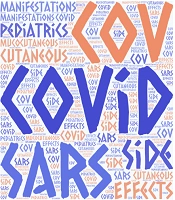1. Context
Coronavirus disease 2019 (COVID-19), caused by severe acute respiratory syndrome Coronavirus 2 (SARS-CoV-2), was first reported in Wuhan, China, in December 2019 and soon became a serious public health issue and later a pandemic in March 2020 (1). At the beginning of the pandemic, children were thought to be resistant to infection, and many children with COVID-19 were probably overlooked due to asymptomatic or oligo-symptomatic infection occurring in most children (1, 2). Early pediatric patients were reported from China and Italy (3, 4) with fever and respiratory symptoms. Although COVID-19 in previously healthy children is more likely to be mild, severe conditions such as multi-system inflammatory syndrome (MIS) were also reported in the pediatric population (5, 6).
Based on many previous studies, mainly case reports, cutaneous manifestations are seen in COVID-19, especially in ill adults and asymptomatic children (5). However, their exact prevalence is unknown because of dermatology consultation hesitancy during the pandemic.
2. Results
COVID-19-related cutaneous manifestations in children can be categorized regarding their clinical manifestations or etiology: (1) a large group of them are induced directly by the disease: the virus itself or its immune response; (2) some are treatment-related adverse events; (3) some might appear after vaccination against SARS-CoV-2; (4) the rest of them are seen as an indirect consequence of the pandemic, such as irritant dermatitis resulting from frequent hand washing (7) or stress-induced worsening of some chronic dermatoses such as atopic dermatitis and psoriasis (8) as a result of social isolation (9).
Regarding the appearance, cutaneous manifestations can be categorized as acral pseudo-chilblains, urticarial lesions, maculopapular rash, vesicular eruptions, and livedo or necrosis (10, 11). Pseudo-chilblain lesions and maculopapular rash on the acral sites are frequently seen in children with COVID-19 (12, 13). They were reported as the most common skin lesions by Shah et al., evaluating 149 children with COVID-19 (14).
Moreover, lesions similar to some exanthemas, which have previously been reported to associate with viral infections, were seen in some affected children, such as erythema multiform-like lesions, purpuric eruptions, varicella-like lesions, and Gianotti Crosti syndrome (15, 16). However, there seem to be some differences in appearance and clinical course in COVID-19 compared to other viral or rheumatologic etiologies that might be used as clinical clues for correct diagnosis. Erythema or maculopapular rash in viral illness generally has a cephalo-caudal distribution and heals with exfoliation, but in COVID-19, it is more likely to be on the acral sites of hands and feet and frequently progress to vesiculation and crusting (14). Moreover, the happening of chilblain-like lesions during the pandemic in the absence of coldness and humidity, positive personal or familial history of Raynaud’s phenomenon or autoimmune disorders, and other secondary causes of chilblain strongly lead us to the diagnosis of COVID-19.
A recent study of 50 children hospitalized with COVID-19 revealed frequent mucocutaneous manifestations (11). Moreover, patients with mucocutaneous lesions were more likely to have a poor general status and were older than those without skin lesions. Andina-Martinez et al. also found that up to 90% of patients with MIS had some mucocutaneous lesions (11). Another interesting finding of this study was that unlike patients without the need for admission, skin exanthema in hospitalized children was more likely to appear on the trunk and limbs rather than the acral sites of hands and feet. They suggested that truncal exanthema and conjunctival hyperemia on admission might be considered prognostic factors to predict a higher possibility of the need for pediatric intensive care unit (PICU) admission (11).
Other mucosal lesions reported in the pediatric population consist of pseudomembranous candidiasis, geographic tongue, coated tongue, taste alteration, and hyperemic pharynx (17).
Regarding the etiopathogenesis of cutaneous manifestations, a multicenter study by Carazo Gallego et al. on 62 children with skin manifestations of COVID-19 revealed that chilblains and vesicular lesions were more likely to occur in those with positive SARS-CoV-2 serology and the maculopapular or urticarial rash was more common in patients with negative antibodies (18). This may reflect the different etiopathogenesis of skin rashes in COVID-19. In fact, one can infer that pseudo-chilblain and vesicular lesions are directly linked to antibody formation and can be considered as immunologic-based reactions in comparison to the direct effect of the virus.
Based on the fact that antibody formation needs time, some immunologic-based responses such as Gianotti Crosti syndrome usually appear after the resolution of the disease (19). Hence, assessing the temporal correlation of skin lesions such as chilblain or vesicular rash with the clinical course of COVID-19 might shed more light on the exact pathogenesis of COVID-19-related cutaneous manifestations. Unlike adults (20, 21), treatment-related cutaneous lesions are rare in children. However, one case with the temporal correlation of skin lesions with hydroxychloroquine was discussed in the literature (14).
The authors of this study have focused on the immunologic aspects of various topics in dermatology and recently turned their focus on COVID-19-associated dermatologic topics (22-28) as an issue of great importance discussed in this paper. Since the vaccination of children was not started across the world until the last update of this review, vaccine-related cutaneous reactions in children should be dealt with in future studies. However, nonspecific skin rash was seen in four infants whose breastfeeding mothers received a COVID-19 vaccine (29).
3. Conclusions
In conclusion, different cutaneous manifestations are seen in children with COVID-19 infection, and clinicians should be aware of them and advocate early isolation while encountering unexplained skin lesions to prevent infection from spreading.
